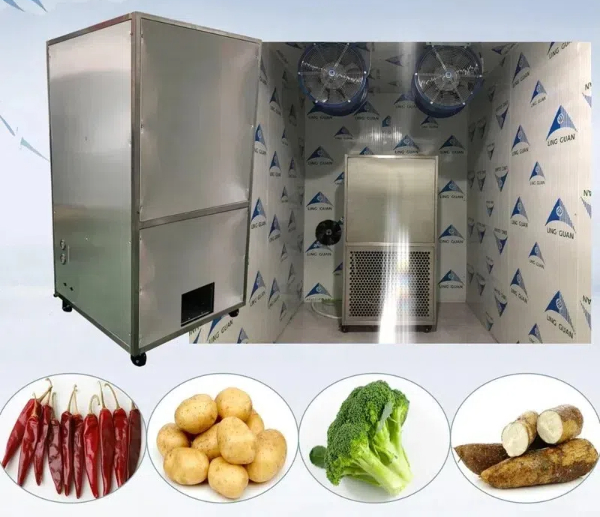
Content Menu
● Introduction to Heat Pump Dryers
>> Advantages of Heat Pump Dryers
● Certification Process Overview
>> Standards for Heat Pump Dryers
>>> ISO 14903
>>> European Directives
>> Testing and Verification
>>> Energy Efficiency Testing
>>> Safety Testing
>> Certification Bodies
● Role of Certification in Market Access
>> Benefits of Certification
● Challenges and Opportunities
>> Challenges
>> Opportunities
● Case Studies: Successful Certification and Market Expansion
● Future Trends in Heat Pump Dryer Certification
● Conclusion
● FAQs
>> 1. What are the key standards for heat pump dryers?
>> 2. How does certification impact market access?
>> 3. What are the benefits of using heat pump dryers in food processing?
>> 4. What is the role of certification bodies like Kiwa?
>> 5. How can manufacturers overcome the challenges of certification?
● Citations:
As a leading OEM provider for food drying equipment, understanding the certification process for heat pump dryers is crucial for ensuring compliance with international standards and enhancing market competitiveness. This article will delve into the intricacies of the certification process, focusing on heat pump dryers used in the food industry.

Introduction to Heat Pump Dryers
Heat pump dryers are innovative devices that utilize heat pump technology to efficiently dry food products. They offer significant advantages over traditional drying methods, including energy efficiency, reduced environmental impact, and improved product quality. These benefits make heat pump dryers an attractive option for food manufacturers seeking to modernize their drying processes.
Advantages of Heat Pump Dryers
- Energy Efficiency: Heat pump dryers can achieve higher energy efficiency compared to conventional drying methods, as they reuse heat that would otherwise be lost.
- Environmental Benefits: By reducing energy consumption, heat pump dryers contribute to lower greenhouse gas emissions.
- Product Quality: The controlled drying environment helps preserve the nutritional value and texture of food products.
Certification Process Overview
The certification process for heat pump dryers involves several key steps:
1. Standards Selection: Identify relevant international standards for heat pump dryers, such as those set by ISO or European directives.
2. Design Review: Ensure the dryer design meets all specified standards, focusing on aspects like safety, efficiency, and hygiene.
3. Testing and Verification: Conduct thorough testing to verify compliance with selected standards.
4. Certification Application: Submit the test results and design documentation to a recognized certification body.
Standards for Heat Pump Dryers
Standards like ISO 14903 provide guidelines for the type approval testing of components used in refrigerating systems and heat pumps. In Europe, compliance with directives such as the ErP (Eco-design Requirements for Energy-related Products) is mandatory.
ISO 14903
This standard outlines requirements for hermetically sealed and closed components used in refrigerating systems and heat pumps, ensuring safety and performance.
European Directives
- ErP Directive: Focuses on energy efficiency and environmental impact.
- EMC Safety: Ensures electromagnetic compatibility to prevent interference with other devices.
- Electrical Safety: Mandates compliance with electrical safety standards to protect users.
Testing and Verification
Testing involves evaluating the dryer's performance under various conditions to ensure it meets the required standards. This includes assessing energy efficiency, safety features, and environmental impact.
Energy Efficiency Testing
Energy efficiency is measured using metrics like the Coefficient of Performance (COP), which indicates how effectively the dryer uses energy to produce heat.
Safety Testing
Safety tests verify that the dryer complies with electrical and thermal safety standards, protecting users from potential hazards.
Certification Bodies
Certification bodies like Kiwa offer comprehensive testing and certification services for heat pump dryers. These organizations provide internationally recognized certificates, facilitating market access for certified products.

Role of Certification in Market Access
Certification plays a crucial role in gaining market access, especially in regions with stringent regulatory requirements. Certified products are more likely to be accepted by consumers and regulatory bodies, enhancing brand credibility and competitiveness.
Benefits of Certification
- Market Access: Certification facilitates entry into new markets by demonstrating compliance with local regulations.
- Brand Credibility: Certified products are perceived as safer and more reliable, boosting consumer trust.
- Competitive Advantage: Certification can differentiate a brand from competitors, especially in crowded markets.
Challenges and Opportunities
While the certification process presents challenges, it also offers opportunities for innovation and growth.
Challenges
- Complexity: Navigating multiple standards and regulations can be complex and time-consuming.
- Cost: Testing and certification can be costly, especially for small manufacturers.
Opportunities
- Innovation: The need for certification drives innovation, as manufacturers must continually improve product design and efficiency.
- Market Expansion: Certification enables access to new markets, expanding business opportunities.
Case Studies: Successful Certification and Market Expansion
Several companies have successfully leveraged certification to expand their market presence:
- Case Study 1: A European food drying equipment manufacturer achieved certification under the ErP directive, enabling them to enter the Asian market by demonstrating compliance with international energy efficiency standards.
- Case Study 2: An American company specializing in heat pump dryers obtained ISO 14903 certification, which facilitated partnerships with major food processing companies worldwide.
Future Trends in Heat Pump Dryer Certification
As technology evolves, future trends in certification will focus on:
- Sustainability: Certifications will increasingly emphasize environmental sustainability and carbon footprint reduction.
- Digitalization: The use of digital tools and IoT technology will become more prevalent in testing and certification processes.
- Global Harmonization: Efforts to harmonize standards across regions will continue, simplifying the certification process for manufacturers.
Conclusion
In conclusion, the certification process for heat pump dryers is a critical aspect of ensuring compliance with international standards and enhancing market competitiveness. By understanding and navigating this process effectively, manufacturers can leverage certification to drive innovation, expand market access, and build brand credibility.

FAQs
1. What are the key standards for heat pump dryers?
The key standards include ISO 14903 for type approval testing of components and European directives like ErP for energy efficiency.
2. How does certification impact market access?
Certification facilitates market access by demonstrating compliance with local regulations, enhancing brand credibility, and providing a competitive advantage.
3. What are the benefits of using heat pump dryers in food processing?
Heat pump dryers offer energy efficiency, environmental benefits, and improved product quality, making them an attractive option for food manufacturers.
4. What is the role of certification bodies like Kiwa?
Certification bodies like Kiwa provide comprehensive testing and certification services, offering internationally recognized certificates that facilitate market access.
5. How can manufacturers overcome the challenges of certification?
Manufacturers can overcome challenges by investing in design improvements, leveraging expertise from certification bodies, and prioritizing innovation to meet evolving standards.
Citations:
[1] https://www.food-safety.com/articles/5008-certifying-process-equipment-whate28099s-involved
[2] https://www.kiwa.com/en/markets/energy-and-power-generation/hvac-and-kitchen-appliances/heat-pumps/
[3] https://unimac.com/international/zh-hans/
[4] https://www.ok.org/article/spray-drying-and-kosher-certification-programs-how-to-make-them-work-together/
[5] https://www.energystar.gov/sites/default/files/ENERGY%20STAR%20Final%20Version%201.1%20Clothes%20Dryers%20Specification%20-%20Program%20Commitment%20Criteria%20and%20Eligibility%20Criteria_0.pdf
[6] https://huebsch.com/cn/
[7] https://www.dryeratech.com/news/Dryer-Certification-Process.html











